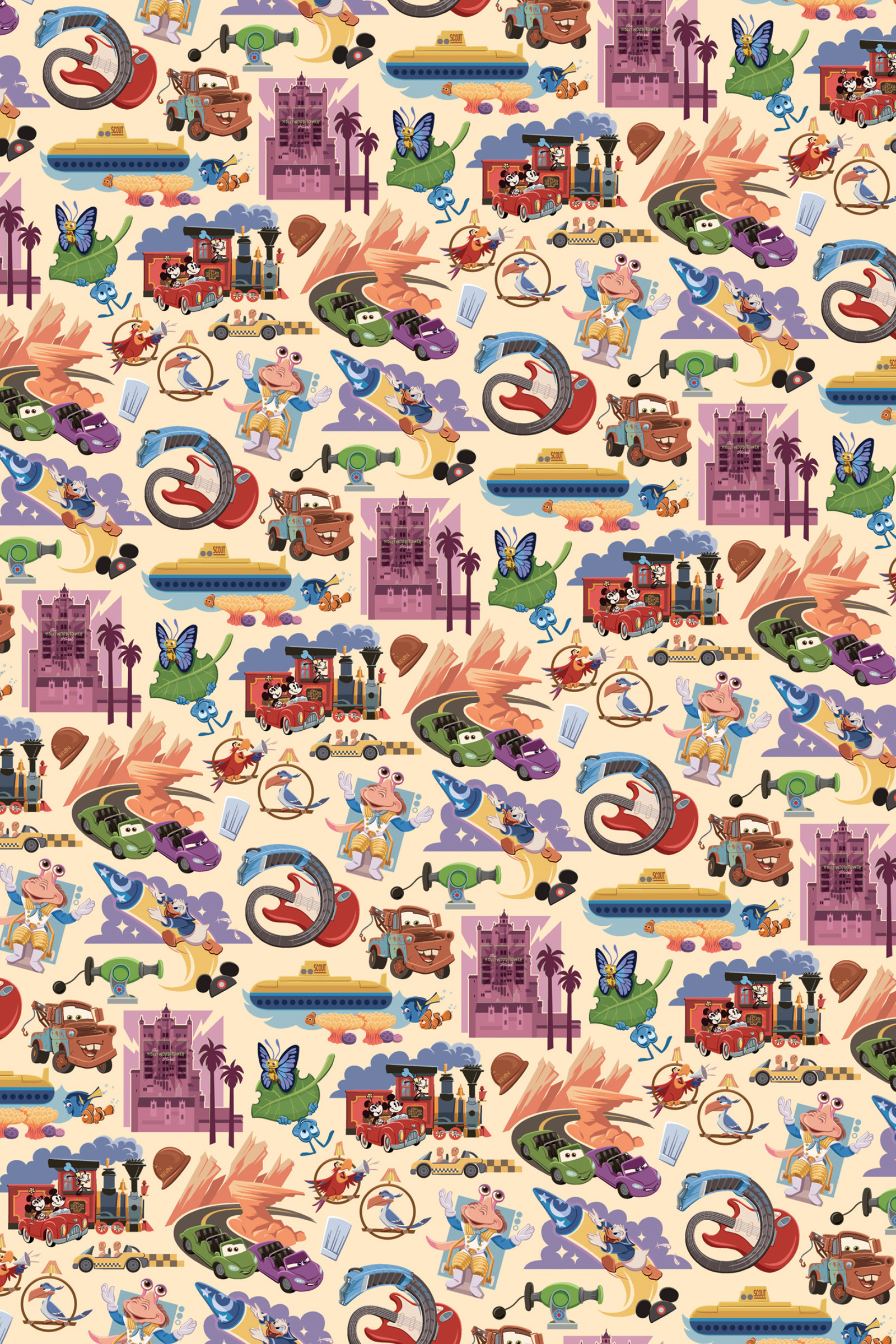

THE ORIGINAL Carousel of Progress is, in my humble opinion, one of the greatest theatrical presentations of all time. The version that debuted at the 1964 World’s Fair in New York and was moved to Tomorrowland in Disneyland in 1967 will always be one of my favorite Audio-Animatronics shows. This innovative combination of a theatrical venue and rotating ride system is the perfect example of Imagineering showmanship at its best. The writing was spot-on brilliant; the timing impeccable; the characters and sets charming, believable, and relatable; and the optimistic and beloved song, “There’s a Great Big Beautiful Tomorrow,” is one of the Sherman brothers’ very best.
One of my favorite memories as a kid (not just one of my favorite memories at Disneyland, but one of my favorite childhood memories period) is sitting next to my father in the Carousel and hearing him sing that song louder and with more gusto than the show’s “Father” (voiced by Rex Allen, who had plenty of gusto himself) as the entire building rotated like a giant wheel to move the audience progressively from scene to scene. As an employee of the Southern California Gas Company, Dad brought home tickets to Disneyland once a year for the “Gas Company Night” private party. During that time in the 1960s, many new neighborhoods featuring “Medallion” homes started to spring up all over Southern California. Medallion signified the homes were all electric and furnished with General Electric appliances, not gas, which made GE the gas company’s competition. In one scene from Carousel, when his dog, Sport, barks at an audience member, Father scolds him. “Now stop that!” he says. “He may be a good customer of General Electric.” After that line, the gas company audience would always boo. Except for my dad. He’d tell everybody to pipe down, “or I’ll give ya something to boo about!” Dad loved the Carousel of Progress as much as I did, so it was a must-see whenever we went to Disneyland. With all that love for the show and personal history that goes along with it, imagine my surprise and delight when Marty Sklar and Bob Weis asked me to take a stab at updating the Carousel at the Magic Kingdom in Walt Disney World.
The Disneyland show was closed in 1973 and moved to Walt Disney World, where it opened in 1975, one year after America Sings! moved into the rotating building in Disneyland’s Tomorrowland. When it reappeared at the Magic Kingdom, it featured a new song written by the Sherman brothers called “The Best Time of Your Life,” performed by the new voice of Father, Andrew Duggen. In 1992, when I stepped in to give the show a refresh, a new generation of guests had never heard “There’s a Great Big Beautiful Tomorrow.” Both songs were optimistically wonderful and appropriate, of course, but because I wanted to change the name of the attraction back to Walt Disney’s Carousel of Progress, it seemed only fitting that we bring back the song the Shermans wrote as a tribute—unbeknownst to him at the time—to Walt Disney. I also thought, in the spirit of change, it would be fun to celebrate a special time of the year for each scene, such as Halloween and the Fourth of July. I asked my musical partner, George Wilkins, to jump in to bring the Shermans’ original theme song back and to arrange it, with his own special twist, in the time periods and seasons depicted.

With a fun nod to Marty, Bob Weis left this note stuck to a piece of paper in my office asking me to work on a revised show for the Carousel of Progress at the Magic Kingdom in Walt Disney World.
Bob Weis and I went to the Magic Kingdom to see the last show before we closed it down to start working on the next version. Afterwards Bob had a great idea, which he is known for from time to time. “Ya know who would be great in the role of Father?” he asked. “Jean Shepherd.” Yes, of course! I was crazy about Bob’s suggestion because I loved American storyteller and humorist Jean Shepherd. I can’t tell you how many times I read his book In God We Trust: All Others Pay Cash. He turned one of the stories in that hilarious and heartwarming book into the screenplay for the holiday movie classic A Christmas Story. He also narrated the movie as the adult voice of Ralphie. Jean Shepherd was the perfect choice for the role of “Father” in this beloved all-American Disney show! And as a nod to Father’s original voice, we cast Rex Allen for the role of Grandfather.

I always looked up to this man as a father figure.
Jean and his wife, Leigh Brown, lived in Florida, so I flew out to meet them and be their host on a grand tour of Walt Disney World. They were both, as expected, warm, wonderful, and genuinely funny, folksy folks. It was such a pleasure to have the opportunity to spend time with and get to know Jean because he shared the stories of his life with me in the same “smile in his voice” narrative style he brought to A Christmas Story. Wherever we were around Walt Disney World, Jean had a wonderfully engaging story to tell related to the place, time, or subject. He talked extensively about growing up in America’s Heartland with his “Old Man,” his tour of duty in the army in Korea, his fish-out-of-water arrival in New York City, and life there with his roommate, poet Shel Silverstein. Another one of his “cut from the same cloth” friends was Earl Hamner Jr., the man who created and narrated, very much in a Jean Shepherd style (albeit not comedic), The Waltons. This prime-time network television show was about a loving family that pulls together in hard times, as narrated by the eldest son, a writer, and every episode of The Waltons always touched and greatly inspired me. The thing about being a productive creative person is, in order to keep delivering the creative goods you have to constantly feed your creative mind, heart, and soul. (Input = output.) As an artist, to do your very best, you have to stay energized and inspired, whether it be with a great book; movie; song; live theatrical, musical, or storytelling performance; art show; dog show; car show. Basically, whatever nourishes your noodle.

I wanted to give Jean Shepherd a Red Ryder BB Gun, but I didn’t want him to shoot his eye out, so I gave him this official Walt Disney Imagineering cap instead. He said it would have made his old man proud.
Spending time with Jean Shepherd, who came to my house to hang out, sip his favorite Maker’s Mark whiskey, and talk about life, his inspiring friends, and his many adventures and misadventures, fed my creative being to the brim. His own personal story about how a shy, picked-on kid from Indiana became a fearlessly vocal radio personality, author, screenwriter, and host of public television’s Jean Shepherd’s America was the stuff of legend. Jean used to broadcast baseball games live on the radio when he was not even present at those games with all the play-by-play excitement he’d have if he were really there. The trick was he’d interpret alphabetic symbols as they would come out of a ticker tape machine as transmitted from someone actually at the game. For example, LF meant left fielder, and since Jean knew every name and position of every player in baseball, that’s all he needed. On one occasion, halfway through the first inning, the ticker tape machine jammed, so Jean, still live on the air, totally made up the rest of the game.
Jean came to California for our recording session for Carousel and my family and I took him and Leigh, both of whom had simple tastes, to a hoity-toity restaurant. When our waiter asked if he wanted sun-dried tomatoes, Jean responded, “What’s with you Californians? Where I come from we call those rotten tomatoes!” Directing Jean Shepherd in our recording studio at Imagineering was truly a career highlight. That is, until we got to the singing part. When you bring talent into the studio to record dialogue, and there is also singing involved in the session, you keep your fingers crossed that that person can actually sing. Well, Jean could not. Not by a long shot. The first note out of his mouth was so awful I thought he was joking at first. But he was not joking as he continued singing with great enthusiasm all the way through to “Just a dream away.”
“Ho, boy, that sounded great, eh?” he said proudly. Music director George Wilkins shot me a wide-eyed “Holy sour note! What do we do now?” look. “Stand by, Jean,” I said. “We’re going to get you some hot tea while I talk to George.” As George and I stepped out of the studio he grabbed my arm and said, “He’s off-key, off tempo, and off his rocker if he thinks he can do this!” “So,” I said, “does that mean you can make this work?” George shook his head. “I’m a musician, not a miracle worker.” “Okay, Jean,” I said upon returning to the studio. “Let’s knock out the rest of the song.” “Oh, ho!” exclaimed Jean, striking a pose like Pavarotti behind the mic. “I’m ready!” It was obvious we weren’t going to come out the other side with any usable material, so we recorded everything in one take. To that Jean said, “I’m even better than I thought!” We covered the base by later bringing in Jess Harnell, a talented character voice actor and singer who has the gift to mimic anyone’s voice in song.
Jess sang in Jean’s style and voice as it might sound in a perfect world and nailed it. When we reopened Walt Disney’s Carousel of Progress in 1993, I invited Jean and Leigh to come see the finished show with my fingers crossed that he wouldn’t be too hurt that we replaced his singing with that of another performer. When Father started to sing “There’s a Great Big Beautiful Tomorrow,” Jean slapped me hard on the leg. I thought the jig was up and I was in big trouble until he exuberantly proclaimed, with his hands flailing about in his excitement, “Holy cow, I really knocked that singin’ out of the park, didn’t I?” “Calm down, Jean,” I said. “Or you’ll put my eye out!” On my birthday that year, Jean gave me an autographed copy of In God We Trust: All Others Pay Cash. Inside he drew caricatures of the two of us and wrote:
Kevin Rafferty,
A great left fielder on his birthday. WALT DISNEY LIVES…
Jean Shepherd
I grew up listening to the reassuring deep gentle voice of singer, songwriter, and movie actor Rex Allen. Known as “The Arizona Cowboy,” Rex found fame in the era of acting and singing cowboys. His records were often spinning on our home phonograph and his voice was often heard on our TV on Sunday nights as he narrated many Disney movies and shows featured on The Wonderful World of Disney. Rex Allen, Disneyland announcer Jack Wagner, and Thurl Ravenscroft (also the voice of Tony the Tiger, and who in his later years lived in a retirement community two blocks from my childhood home) were the vocal soul of the sound of Disney, as their unmistakable voices were immediately recognized as such. Of course, Rex also performed as the Audio-Animatronics host of the Carousel of Progress during that time when those Disney voices were all at the happy heart of that classic Disneyland soundscape. Having the opportunity to direct Rex Allen for our later version of the Carousel show was a humbling experience.
One thing I discovered over the years is every time legendary talent comes to our Imagineering recording studio, they bring along their personal stories; stories you have never heard or read. Or even if you have, you get to hear them directly from the source. That means at least half of the time allotted for a recording session is taken up by storytelling, prior to the session and between takes. But I wouldn’t have it any other way. When I told Rex what an honor it was for me to be directing him since I grew up hearing his voice, he started reminiscing about his own childhood. He told me that when he was old enough to leave his life on the ranch to come to California and follow his dream to become an entertainer, his father didn’t embrace that idea too well at all. After finding fame, Rex bought a ranch-style house in California’s San Fernando Valley and invited his dad to come visit. But he refused. Rex had to bribe him with the promise to buy him a new pickup truck if he’d honor the invitation. After Dad drove his new truck from the Valley dealership to Rex’s house, they celebrated his visit with a backyard barbecue by the pool. Afterwards, Rex asked his rancher father, who had never stepped booted foot out of Arizona, “Well, pa, what do you think of California?” “Son,” he responded, “I just can’t get used to how you California people do all your eatin’ outside and all your shittin’ inside.”
Rex Allen was a longtime friend of Roy E. Disney. When Roy found out he was coming to Imagineering for a recording session, he called to ask that I let him know when his old friend was there because he wanted to come over and surprise him. Rex was a smoker and we didn’t allow him to light up in the building. So, between takes, he’d go out back to our loading dock for a cigarette. When Roy arrived, I asked him to wait in the small visitor’s room a few doors away from our studio while I went to fetch Rex who was outside having a smoke. Not pleased that he had to put out his perfectly good cigarette to follow me in, Rex entered the visitor’s room shocked to discover Roy puffing on his own cigarette. “Roy Disney,” Rex said sternly to his old friend, “why do you get to sit there and have a smoke inside when they make me go outside?” “Well, Rex,” Roy answered as he took a long deliberate drag on his cigarette, “My last name ain’t Disney for nothin’.’”
Our refresh of Walt Disney’s Carousel of Progress was actually part of the bigger revamping of Tomorrowland at the Magic Kingdom. Tomorrowlands are always the toughest lands to create or change because by the time you build one with the intent to showcase the future, the future has already become the past. Led by Paul Osterhout (who also performed the son’s voice in the final act of the Carousel), the future we landed on for the New Tomorrowland was a playful version of the “future that never was.” In this whimsical machine-age-meets-early-sci-fi-comics future, robots cut your hair and walk your dog, and citizens live out in the hoverburbs. With the real future being showcased and changed out regularly in Innoventions at Epcot, we invented a fantasy “Community of Tomorrow” where the attractions and other elements all became part of the neighborhood. The ExtraTERRORestrial Alien Encounter attraction, for example, took place in the Tomorrowland Convention Center, and Space Mountain was the community spaceport. To tie it all together, the Tomorrowland Transit Authority (TTA) transported citizens around the community to see its many sights from great heights. I thought it would be funny to give the smallest shop in the land the longest name. It was a kiosk, really. I named it Ursa Major Minor Mart.
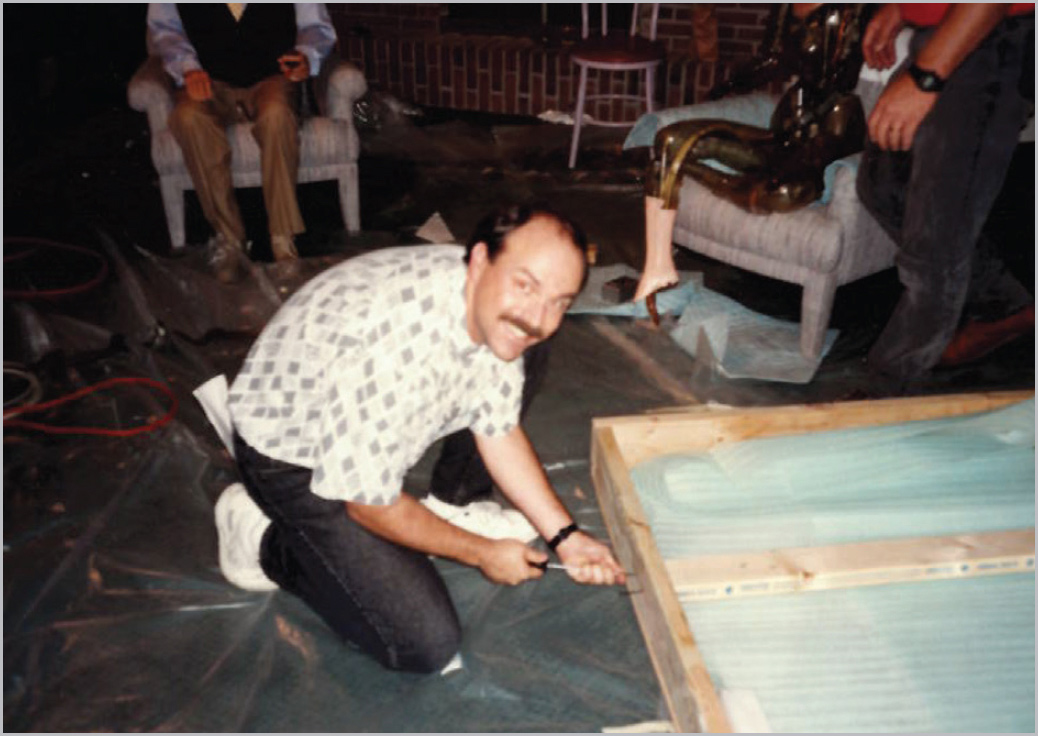
Carousel of Progress—some assembly required!
After our work in the land was complete, Executive vice president Eric Jacobson called me in my office back home in Glendale. “Hey, Kev, guess what?” Eric began. “Thanks to you a baby was almost born in Tomorrowland today.” Well that certainly got my attention! Eric continued to tell me there was an emergency situation in which a woman went into labor and almost didn’t get the help she needed in time because of me. When the security cast member called for help on his radio while the poor woman was screaming with labor pains in the background, the dispatcher immediately went into action asking for his location. “We’re next to the…the…uh, you know, the…Minor…the Major…the Minor Major…no, that’s not it.…No…we’re next to the Major Ursa…we’re at, ummmm…Ursa.…Something about Ursa…you know, that Mart, that…Ursa Mart place. WE’RE BY THAT LITTLE SHOP THAT SELLS FILM IN TOMORROWLAND! HURRY!”
Not far from the Ursa Major Minor Mart, in the spaceport spirit of the community of Tomorrowland, I changed the name of the Tomorrowland Terrace Restaurant to Cosmic Ray’s Starlight Café. Similar to Pan Galactic Pizza Port at Tokyo Disneyland, Cosmic Ray’s is an intergalactic restaurant franchise on Earth. Appearing “live” in its main dining room is “The Biggest Little Star in the Galaxy,” Sonny Eclipse, an intergalactic lounge act who sings while playing the Astro Organ. Prior to his gig at Cosmic Ray’s, Sonny performed at mall openings, bar mitzvahs, and weddings all over the galaxy. He’s a big deal on his planet, but on our planet he’s really down to earth. Honestly, I don’t know how I ever sold the idea for Sonny Eclipse. He doesn’t bring in any extra cash or even have a tip jar, which would help justify his existence, and he’s too small to be marketable. But somehow—maybe it was my threatening to hold my breath until I turned as blue as Sonny’s cousin Officer Zzyzx—Cosmic Ray was able to hire the intergalactic entertainer.
George Wilkins and I wrote eight original songs for the character. I thought it would be fun for Sonny to sing different types of music, from ballads to rock to blues to “Bossa Super Nova,” so we wrote in all those styles. I penned the lyrics and jokes to reflect Sonny’s outer space perspective. George performed most of the instrumentation for the new tracks and we recorded everything in his garage studio in Sherman Oaks, a section of Los Angeles. Sonny is voiced by Palm Springs, California, blues singer Kal David, who also laid down some string-bending blues riffs on his guitar for the song “Gravity.” We recorded all of Kal’s vocals in George’s laundry room where the microphone was propped up between the washer and dryer. (Yes, dear project management friends, I know how to keep a project under budget!)
When Sonny first appeared at Cosmic Ray’s Starlight Café, he rose to the occasion on a lift that carried him to the stage. I can’t tell you how thrilled I was the first time I saw guests responding to him with their fingers snapping and toes tapping—and some of them even danced to his musical stylings. Imagine my surprise when I read a newspaper article about two Disney park fans who fell in love while dancing to “their” song, “Bright Little Star” by Sonny Eclipse! Sonny introduces that song by telling the audience how much he misses his girlfriend and that he wrote it with her in mind:
O bright little star, though I’m light-years away from her now
I can’t help but to feel that somehow we’re both wishing on you
I imagine your light in her eyes as she gazes up into the skies
At this moment, does she realize you are in my eyes, too?
O bright little star, is she wishing the same wish as me
That somewhere out in space there may be a nice planet for two
Where someday we’ll be all alone in our own galaxy
Dancing under a star canopy and our favorite is you
Someday somewhere I will find her in the universe up above
Tell her, little star, I’ll surround her with all my love
Good night, little star, watch and keep her till we meet again
In the glow of a love without end shining brightly like you do
And every night as we gaze at your loving starlight
We will know that when wishes are right they will always come true.
After singing that song about love, Sonny, who is big and green, performs a blues number about the second strongest earthly force:
Gravity you’ve got a hold on me, yes you do, yes you do
Gravity you’ve got a great big hold on me, oh, yeah
I can’t see ya, can’t even feel ya, and now I know you will never set me free
Since the world is round, must be people upside-down
What’s keepin’ them from falling off and floatin’ all around?
All those people down under are beginning to wonder
If you would ever cut the juice and set ’em loose, good-bye!
Hello, gravity, mean old gravity
I am green but gravity you’re giving me the blues
Gravity set me free, you’re a magnet of course, a famous earthly force
Yeah, gravity let me be
If it weren’t for you I wouldn’t weigh what I do
Gravity you’re weighin’ heavy on my mind all the time
Gravity why do you treat me so unkind? I never did nothin’ to you!
I can’t see ya, can’t even feel ya
But I’m green and gravity you’re giving me the blues.
During the same time Sonny and all of the New Tomorrowland work were going on, my old pal Joe Lanzisero, who was leading the design and development for a new land in Disneyland called Mickey’s Toontown, asked me to jump in and work on overall gags for his project, which included partnering up with George Wilkins to create the “Toontown Radio Show.” When completed, the “live radio program” was broadcast over two toon-themed radios; one was in Mickey’s house and the other was in the garage-themed load area of Roger Rabbit’s Cartoon Spin. The call letters for the radio station were W-A-C-K-Y. Writing the “Wacky Radio” program, which included news and advertisements for local Toontown businesses (including the ad jingles and songs sung by some of the characters), was a joy because it was right up my alley. My favorite ad jingle was for the Three Nephews from Duckburg Catering Company:
Three nephews from Duckburg will help you if you’re stuckburg
If you don’t have the time to fix a meal
They’ll do all the cooking without you even looking
Call them for a booking, what a deal!
Your guests, they will love ya, they’ll put you high above ya
Their taste buds will shout out “ooh la la!” (ooh la la!)
So, put on your favorite tux, leave the cooking to the ducks
Three nephews from Duckburg
Try Huey and Dewey and Louie’s ratatouille
Their Swedish meatballs really hit the spot—yeah! (plop!)
If it’s catering you want make your home a restaurant
Three Nephews from Duckburg!

From left to right, fellow show writer Art Verity, character voice actor June Foray, and me. I grew up hearing all of June’s voices, from Rocky the Flying Squirrel to Natasha Fatale. We were recording material for Mickey’s Toontown that day.
Throughout the radio show there would be breaking news reports about the weasels and Dip to shill the story of Roger Rabbit’s Cartoon Spin. Fellow show writer Art Verity and I wrote the story setup for that attraction featuring fiendish plans being devised by the weasels as overheard in the queue. This effort provided a glorious opportunity for me to get to write for and direct a legendary cartoon voice talent I adored my entire life: June Foray. I think my mom’s was the only other female voice I heard more through the years. June was the voice of Rocky the Flying Squirrel, Natasha Fatale (from Boris and Natasha), Cindy Lou Who, and too many more to list.
And speaking of talent I adore, the designer who created the layout and show sets for the attraction was a fresh new face to Imagineering who would later become my longtime creative partner in crime, Rob’t Coltrin. But I didn’t know Rob’t then because I had not yet worked with him, and I didn’t work with him directly on Roger Rabbit’s Cartoon Spin because I was focused primarily on the show in the queue, the layout of which he had already designed.
Rob’t and I were also working on Snow White’s Scary Adventures for the Magic Kingdom at that time; but again, not together. He was the show designer and I was the show writer. As we were both taking separate direction from senior designer Brock Thoman, Rob’t and I, strangely enough, never collaborated with each other. Brock’s assignment was to bring Snow White to the Show White attraction. This sounds weird, I know, but when Snow White’s Adventures opened in Fantasyland at the Magic Kingdom in 1971, Snow was a no show. The thing is, you were supposed to be Snow White. All of the characters played to you, in your ride vehicle, as if you were her. For example, the old hag held the apple out to you, dearie! But over the years many guests reported their disappointment that they didn’t get to see Snow White on her own attraction. Well, that reaction is certainly understandable. By the time I came to the project Brock and Rob’t had the show set package almost completed with Snow White already staged.
My job was to bring the show to life with script, recorded dialogue for all the characters, and musical soundtracks. By that time, Rob’t had moved on, so he and I never even saw each other on that project. I always thought it odd that the two of us worked on two projects together but without personally collaborating on either one. But that was about to change.
The Many Adventures of Winnie the Pooh at the Magic Kingdom in Walt Disney World was the very first of many attractions to come in which Rob’t and I were close creative compadres. When designers Rob’t and his sister, Lori (both now executive creative directors), were ready to bring a show writer on to their project, they asked me to join the Pooh team because Rob’t had put two and two together: we had previously worked together—well, sort of. Working with Rob’t and Lori on that attraction would forever change the way I approached dimensional design and the art of Imagineering. When it comes to theater and showmanship, which is what Imagineering is all about, those two are a focused force. We three clicked instantly. (Today, when the two siblings wrap me in a hug—me the hot dog, them the bun—they give me fair warning beforehand: “Here comes the Coltrin Sandwich!”) Watching Rob’t, a master at up-front design and story, and Lori, a master at “take it to the finish line” theatrical production, was like watching an Olympic relay race. Pure perfection.
I wrote the script and directed the voice talent for The Many Adventures of Winnie the Pooh. Rob’t, Lori, and I were honored to work with Disney Legends Buddy Baker and Richard Sherman on the musical score and with the talented cast of characters. Buddy adapted his same arrangements of the Sherman brothers’ score for the 1977 movie of the same name to fit precisely into the length of each of our attraction scenes. It was sort of the Reader’s Digest condensed version of musical arranging. And Buddy was the best in the business. When it came time for the recording session, Buddy made sure the orchestra was made up of the very same players, as many as were still available, that performed for the original movie score. They also brought along some of the not-so-typical instruments they played for that score. One of the things I love to do most while working on an attraction project is to sit in the recording studio with the orchestra as they perform all of the cues live.
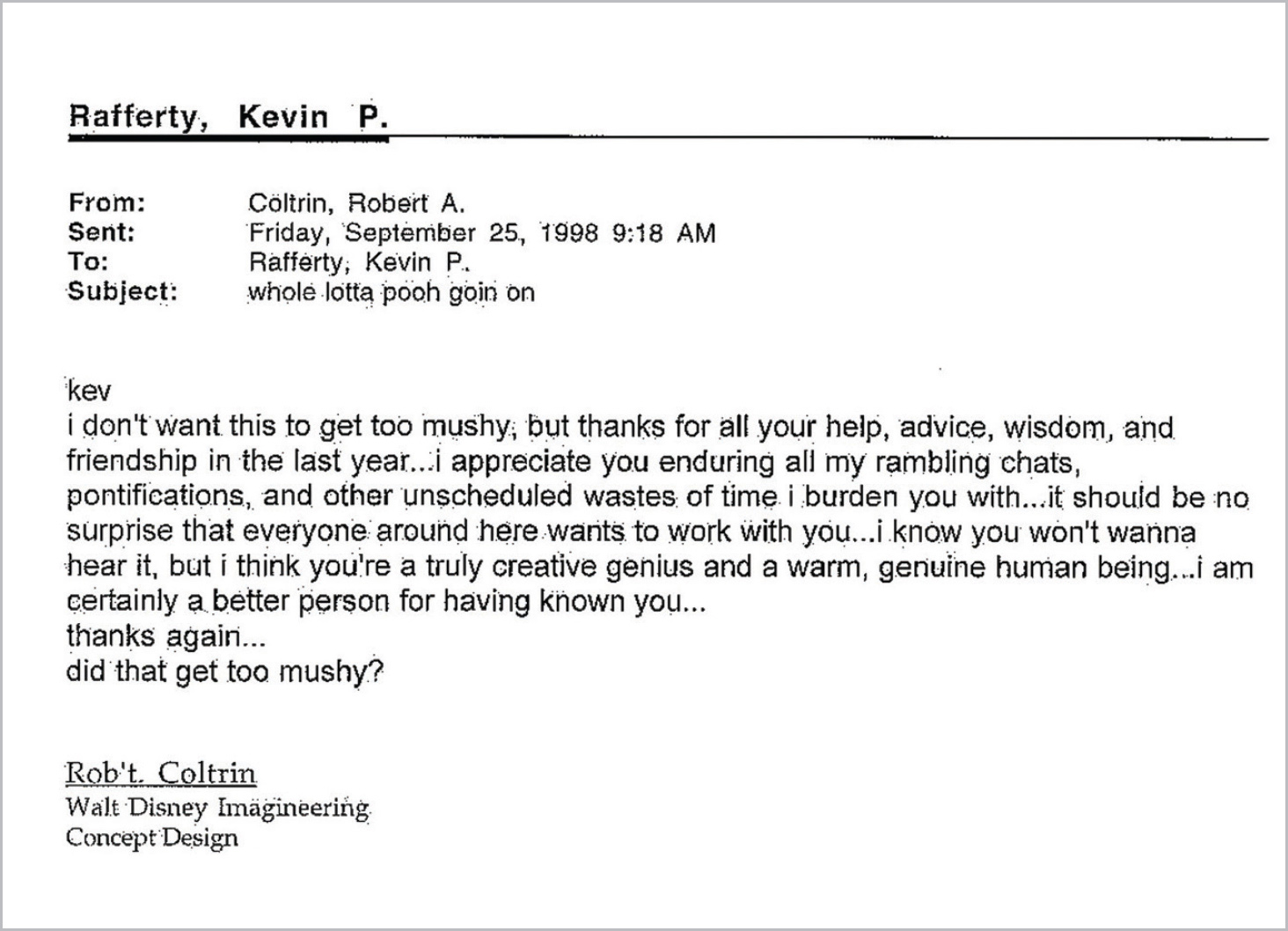
This first of many wonderful and thoughtful notes I would receive from Rob’t through the years. I am certainly a better person for having known him!
Truly, it was a remarkable opportunity for me to be seated among the many members of the orchestra that played for the movie score while the same maestro, Buddy Baker, conducted them. The icing on that honey cake was having Richard Sherman in the house as well. It was as if I had gone back in time to 1976 and was present at that original session.
A few bars after Buddy began conducting the cue for “Heffalumps and Woozles,” Richard stood up and interrupted the orchestra. “Hold on, everybody,” he said while waving his hands as the whole studio suddenly went silent, except for one lone trombone that hilariously improvised the sound of a flying Heffalump coming in for a crash landing—which was, of course, accentuated at the end with an improvised cymbal crash. Richard continued, “Something important is missing.” Bewildered, Buddy lowered his baton and blurted, “Missing? What’s missing?” Richard smiled that magical Richard Sherman smile and answered with one word: “Kazoos!” “Of course!” realized Buddy. “Did anyone bring a kazoo?” Richard added, “We need at least two.” “Two?” I asked. “Why two?” “Because,” Richard answered with a wink, “two are funnier than one!” No one in the orchestra had brought a kazoo. Richard promised Buddy he’d bring two kazoos with him to the session the next day, which he did. And when the orchestra performed the “Heffalumps and Woozles” cue, Buddy and Richard stood side by side in front of the microphone humming joyously into those two funny kazoos.
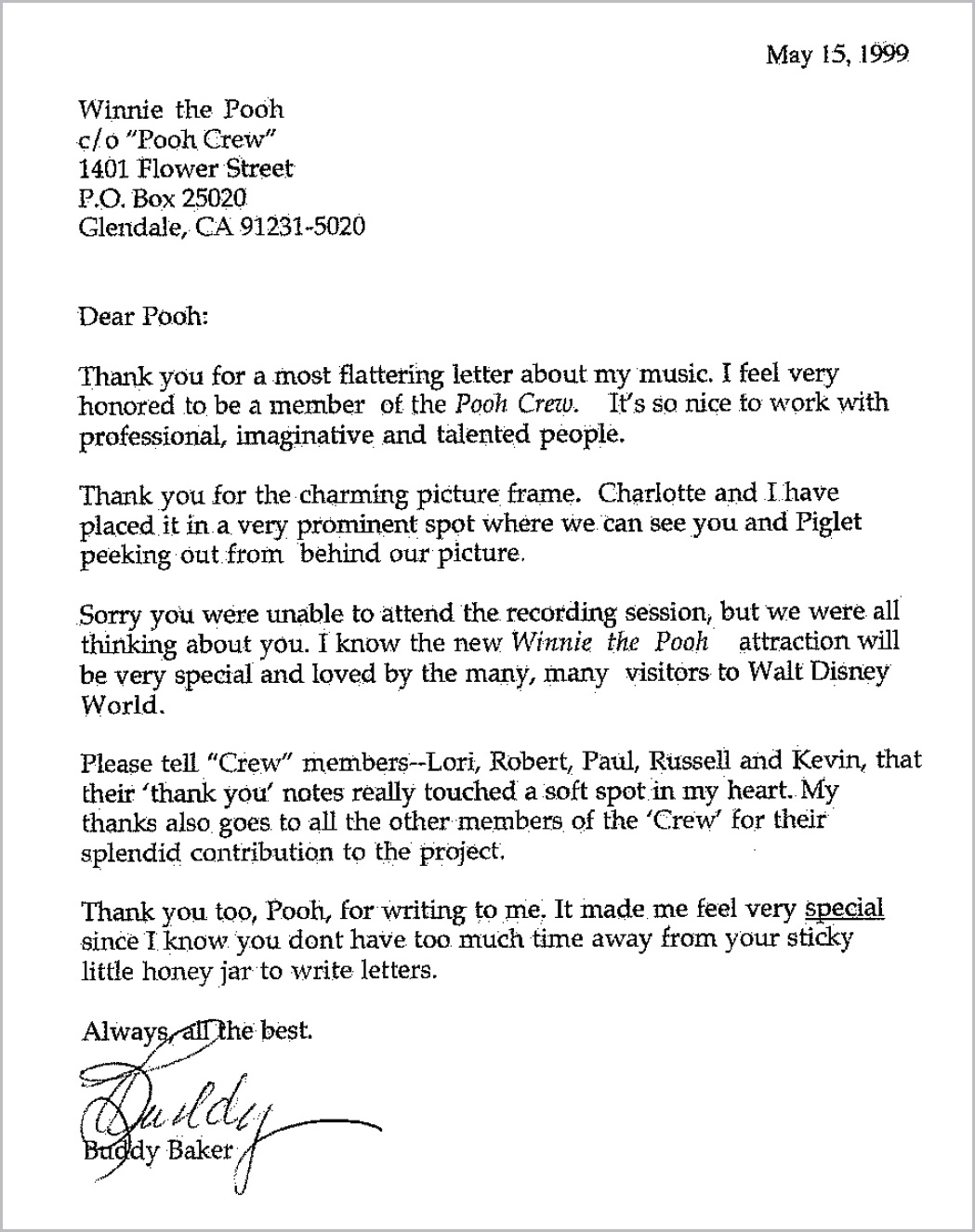
Our “Pooh Crew,” the team that designed and delivered The Many Adventures of Winnie the Pooh for the Magic Kingdom in Walt Disney World, sent Buddy a heartfelt thank-you letter as written by Pooh himself. This was Buddy’s response back to Pooh (us).
Here were two men who had done so much to bring so much to our lives, together in their element, together in their love for one another. And I was there. What a glorious, privileged, once in a lifetime moment to be present with my two musical heroes as they brought to life that big, funny sound on those two tiny kazoos. “Sometimes,” said Pooh, “the smallest things take up the most room in your heart.”
Speaking of heroes (I know, I have a lot of them), while growing up, I never missed The Paul Winchell Show starring ventriloquist Winchell and his two dummies: Jerry Mahoney and Knucklehead Smiff. Paul was also famous for being the bouncy, trouncy, flouncy, pouncy voice of Tigger. While directing the character voice talent for our attraction, one of the most memorable moments of my career occurred during our recording session with the very same Paul Winchell. Before I escorted him into our recording studio, Paul pulled Rob’t, Lori, and me aside to let us know that this was going to be his final performance as Tigger. After more than thirty-five years of performing that character’s voice, he was going to retire after our recording session. Being informed of that news immediately before our session naturally put us in a somber mood, which is not where you want to be when you’re about to record such an upbeat character. Paul sensed our sadness, and staying true to the high-spirited, happy-go-lucky performer he always was, went right to work making the session, as Tigger would put it, “Fun, fun, fun, fun, fun.” I was the last person ever to direct Paul Winchell performing the voice of this most beloved character. After he covered all of the material, Paul asked if he could perform one more line for the road. “Of course,” I said to the entertainer I admired so much. “The microphone is all yours. And we’re rolling.” Paul winked at me, took a deep breath, and said, “TTFE. Ta-ta for ever.”
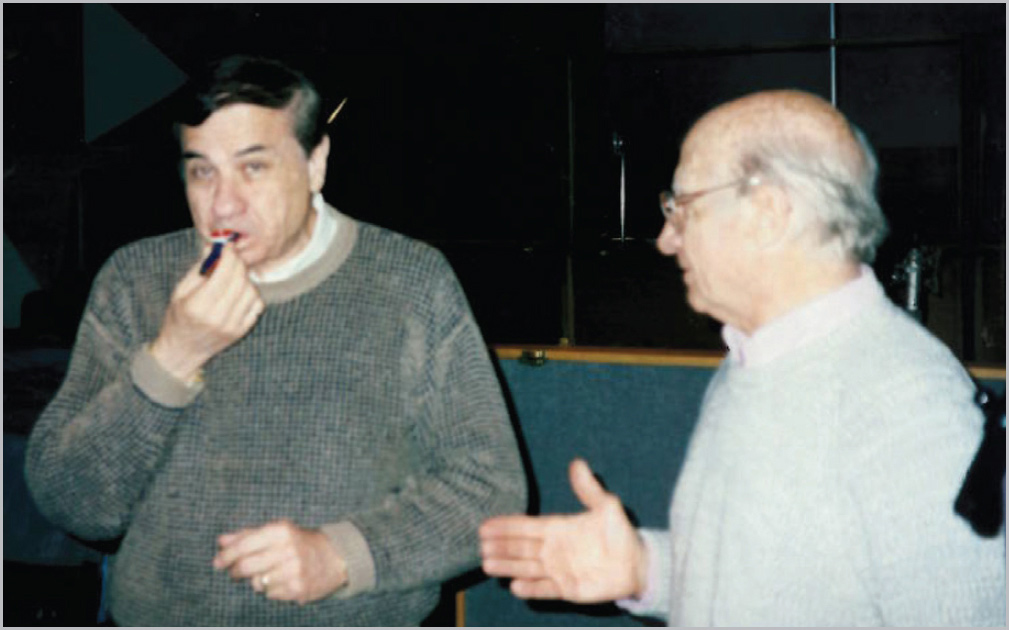
Here’s how Richard Sherman brings a Heffalump to life!

Having the oppor-TUNE-ity to work with my all-time favorite music legends, Buddy Baker, Richard Sherman, Alan Menken, and Michael Giacchino, has to be one of the biggest joys of my career. I’m smiling because I get to be an Imagineer and a songwriter!
Although I did not work on The Many Adventures of Winnie the Pooh at Disneyland, which shares the same name (but is a different attraction experience), that project team did use the music and vocal soundtracks we created for our Magic Kingdom version. In either location, you can hear Buddy and Richard’s performance together on the kazoos and Paul Winchell’s final performance as Tigger. I consider it a rare gift that I was present at both recording sessions and was able to contribute to the design and development of this timeless attraction honoring one of the world’s most endearing characters. Lori, by the way, went on to deliver two more renditions of our Magic Kingdom version of the attraction for Hong Kong Disneyland and Shanghai Disneyland. Helping create the first Magic Kingdom version of The Many Adventures of Winnie the Pooh was an adventure in itself, and thanks to Rob’t, Lori, Buddy, Richard, and Paul it was certainly no “bother.” “How do you spell ‘love’?” asked Piglet. “You don’t spell it,” said Pooh. “You feel it.”
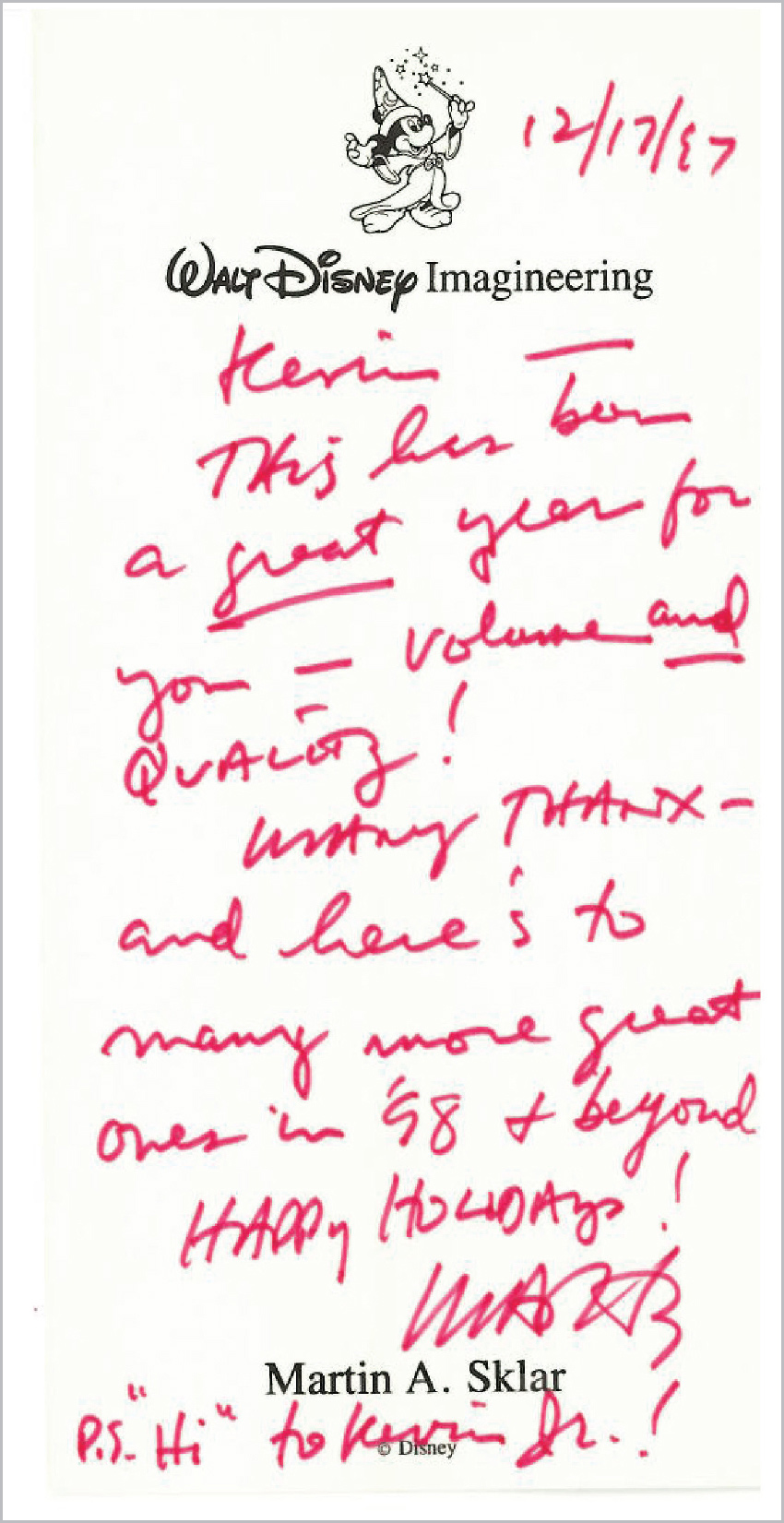
Thanks, Marty! I’ll be looking for that raise in ’98!
The 1990s were a blustery daze of nonstop work—a blur, really. In addition to the projects I’ve already mentioned in this chapter, it was the busiest chapter in my life because I was also working, sometimes simultaneously, on Blizzard Beach and the Winter Summerland Miniature Golf for Walt Disney World; Mickey’s Toontown Fair and The Enchanted Tiki Room—Under New Management! for the Magic Kingdom; a hardcover book, Walt Disney Imagineering—A Behind the Dreams Look at Making the Magic Real; it’s tough to be a bug! for Disney’s Animal Kingdom; Test Track for Epcot; Rock ’n’ Roller Coaster Starring Aerosmith for Disney’s Hollywood Studios; and Rocket Rods (preshow lyrics) and host Tom Morrow’s introduction to Innoventions for Disneyland. It’s a good thing I’ve always had Tasmanian devil–level whirling, twirling energy—much to the chagrin of my wife—who frequently tells me, “You need to learn how to sit down and relax!” Well, honey, I’ll have to relax later, because the time has come for the talk about the birds and the bees.
